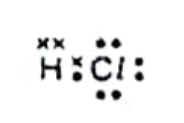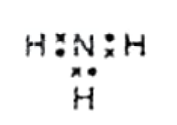Which electron arrangement for the outer shell electrons in a covalent compound is correct ?




To solve the question regarding the correct electron arrangement for the outer shell electrons in a covalent compound, we will analyze the options provided and determine which one is accurate.
1. Understanding the Question: The question asks for the correct electron arrangement of outer shell electrons in a covalent compound. We need to evaluate the given options.
2. Evaluating Option A:
- Option A shows four electrons around hydrogen.
- Analysis: Hydrogen can only have a maximum of 2 electrons in its outer shell (1s² configuration). Therefore, this option is incorrect.
3. Evaluating Option B:
- Option B shows 6 electrons around an atom.
- Analysis: The arrangement of 6 electrons is not typical for a stable covalent compound. Most atoms follow the octet rule (having 8 electrons in their outer shell). Thus, this option is also incorrect.
4. Evaluating Option C:
- Option C presents the electron arrangement for nitrogen and hydrogen.
- Analysis:
- Nitrogen has an atomic number of 7, which means it has 5 valence electrons (2 in the first shell and 5 in the second shell).
- Each hydrogen has 1 electron.
- In NH₃ (ammonia), nitrogen shares its three valence electrons with three hydrogen atoms, forming three covalent bonds. This results in nitrogen having a complete octet (8 electrons) when counting the shared electrons.
- Therefore, this option is correct.
5. Evaluating Option D:
- Option D shows an incomplete octet for an atom.
- Analysis: For a stable covalent compound, atoms typically need to complete their octet. If an atom does not have a complete octet, it is not a stable arrangement. Hence, this option is incorrect.
6. Conclusion: After evaluating all options, we find that Option C is the correct representation of the outer shell electron arrangement in the covalent compound NH₃.
Final Answer:
The correct electron arrangement for the outer shell electrons in a covalent compound is Option C.
- Option A shows four electrons around hydrogen.
- Analysis: Hydrogen can only have a maximum of 2 electrons in its outer shell (1s² configuration). Therefore, this option is incorrect.
- Option B shows 6 electrons around an atom.
- Analysis: The arrangement of 6 electrons is not typical for a stable covalent compound. Most atoms follow the octet rule (having 8 electrons in their outer shell). Thus, this option is also incorrect.
- Option C presents the electron arrangement for nitrogen and hydrogen.
- Analysis:
- Nitrogen has an atomic number of 7, which means it has 5 valence electrons (2 in the first shell and 5 in the second shell).
- Each hydrogen has 1 electron.
- In NH₃ (ammonia), nitrogen shares its three valence electrons with three hydrogen atoms, forming three covalent bonds. This results in nitrogen having a complete octet (8 electrons) when counting the shared electrons.
- Therefore, this option is correct.
- Option D shows an incomplete octet for an atom.
- Analysis: For a stable covalent compound, atoms typically need to complete their octet. If an atom does not have a complete octet, it is not a stable arrangement. Hence, this option is incorrect.
The correct electron arrangement for the outer shell electrons in a covalent compound is Option C.
Topper's Solved these Questions
Similar Questions
Knowledge Check
When an electron is added in the valence shell
Aenergy is releasedBenergy is absorbedCenergy remains sameDnone of the above
Which of the following is electron deficient compound :-
View SolutionHow are electrons involved in the formation of a covalent compound.
View SolutionIn the formation of electrovalent compounds, electrons are transferred from one element to another. How are electrons involved in the formation of a covalent compound ?
View SolutionWhich of the following is an electron-deficient compound?
View SolutionWhich of the following arrangements shows the correct order of electron affinity of the four halogen atoms I,Cl,Br,F?
View SolutionWhich arrangement of electrons leads to ferromagnetism ?
View SolutionThr outer electronic configuration of lawrencium is
View Solution
